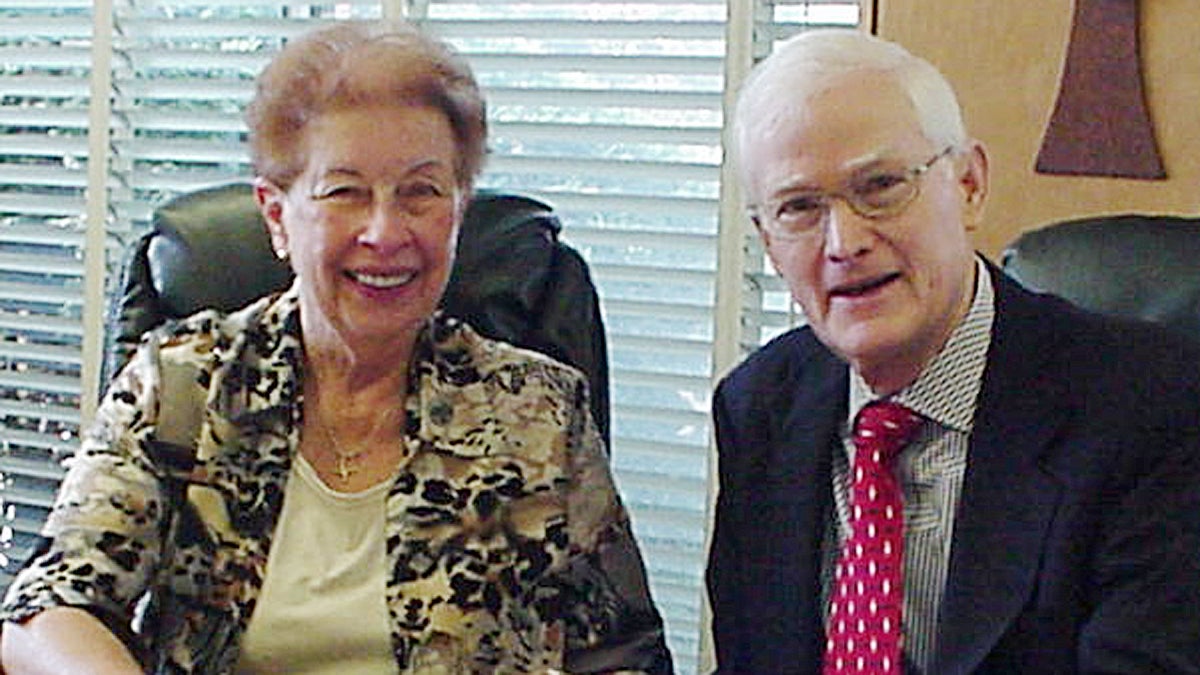Affordable housing group in Bucks County struggling to keep open
Listen
Sister Rita Margraff and Martin Brill, President and Treasurer, respectively, of Interfaith Housing Development Corporation (Image courtesy of Margraff)
JoAnne Rowan, a retired nurse who lives in Levittown, says her living arrangement reflects the state of affordable housing in Bucks County.
“I live with my son because I cannot afford my own place,” Rowan said.
Her son, who’s almost 40, works at a nearby oil company as an inventory clerk and is the primary leaseholder. Her other son, who’s in his 40s, lives with them, too. He’s struggling to find work.
Rowan said splitting their $1,200-a-month rent is the only way she can get by. She’s seen cheaper living arrangements advertised in Bucks Count, but there’s often a catch.
“They always will tell you when they get you to sign on the dotted line,” she said. “And once you sign on the dotted line, that’s when it seems that all the extra charges that you weren’t told about in the beginning start flowing in.”
Tracy Mellor, who leads the Bucks County Housing Group, talks to people like Rowan just about every day.
“The average one-bedroom apartment in Bucks County is $1,050 a month,” Mellor said. “So if you were a single person earning minimum wage, you’d need two full-time jobs to afford your housing.”
Buying a home in the county isn’t much easier. Figures provided by CoreLogic show that the median home price in Bucks County is almost $270,000, compared to $113,000 in neighboring Philadelphia.
That statistic might not be shocking to some. After all, Bucks is one of Pennsylvania’s most wealthy counties. But Mellor says there’s a divide. In the county’s most densely populated portion, in the lower part, around Bristol, Bensalem, Middletown and Levittown, many facing a housing crisis.
“The face of homelessness in Bucks County is often kind of undetectable, because a lot of people who meet the definition of homelessness are actually doubled up, or tripled up with other families,” Mellor said.
Other advocates said it’s not uncommon to hear of families living out of cars, or living temporarily in motels.
It seems like there’s no time is better than now for more affordable housing resources. Yet the intensifying demand comes just as the largest non-government provider of affordable homes in Bucks County is fighting to survive.
“We have very little financial resources other than what the county is providing us and also what we’re getting through fundraising,” said Martin Brill, the treasurer of the Board of Interfaith, a nonprofit that, for nearly 30 years, has partnered with religious groups to find low-income residents housing.
They provide housing to some 80 families with just one full-time property manager and a part-time bookkeeper. Before the housinb bubble burst and the group hit financial trouble, it had more employees.
And their business model had worked like this: Interfaith invests in a property, fixes it up and then sells it to a renter. The home would be worth more by the time they sold it, so they’d make a profit. That money is put into a pot for other expenses, like offsetting housing costs for a struggling tenant. But once homes stopped appreciating quickly, the model unraveled.
“Our goal is to keep people in their houses. We don’t want anyone else to become homeless because of their situation,” said Sister Rita Margraff, president of Interfaith’s board.
One resident Margraff recently work with had to quit her full-time job to tend to her son, who became seriously ill. Eventually, she fell behind on her rent and her other bills kept mounting. Cobbling together income with three full-time jobs, she still strained to meet her rent every month.
“We’re limited. We can only help the people we have housing for right now. And that’s why we’re trying so desperately to keep the people we can in the houses they’re in, so we don’t increase the homeless population,” Margraff said.
Lately, it’s become far tougher for low-income renters looking to buy a home to secure mortgages, Margraff said.
As such, they haven’t embarked on a new housing project in two years.
“Because we’ve been trying to just limit any new activity and just manage the properties we have,” Brill said, noting that one-size-fits-all federal formulas for affordable housing funding is proving to be unsustainable.
It’s a Catch-22: Getting federal aid depends on a renters’ income; but in Bucks County, many of the renters who can afford even subsidized rent make too much to qualify.
“Some of the properties do have federal money, and I think there’s a chance that may have to be paid back,” Brill said.
Some of their renters have fallen behind, making it sometimes tough for the group to make its mortgage payments. In fact, three of their properties are now in foreclosure and scheduled for a sheriff’s auction next month.
Overall, they’ve made payments on time on all their other properties. But they’re in a holding pattern. There’s less money in the pot they reach into to help out their renters.
“I would not like to see them go out of business,” said Roger Collins, Bucks County’s new director of housing and community development. He said the county has invested $3.5 million into Interfaith over three decades.
“At the same time, we have our eyes on the higher goal. And that is: if there’s another way to structure the 85 units to another corporate configuration, we’re open to that.”
He’s put together an advisory board to look into ways to fix the affordable housing supply-and-demand problem.
At Interfaith, members of the board say it might make sense for another group to take over their properties.
“Before us, affordable housing in Bucks County was almost nonexistent,” Margraff said. “And still now, the demand is more than we can help.”
WHYY is your source for fact-based, in-depth journalism and information. As a nonprofit organization, we rely on financial support from readers like you. Please give today.




